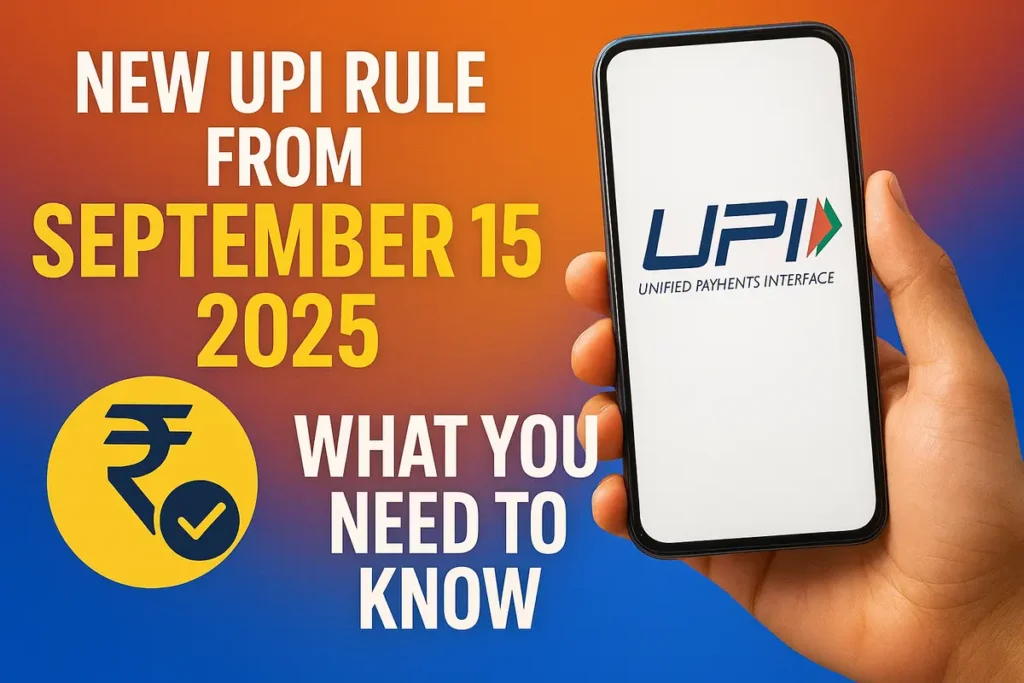
Table of Contents
Introduction
Starting September 15, 2025, significant changes are coming to the Unified Payments Interface (UPI) system in India. These changes are aimed at making large-value payments smoother and hassle-free. The New UPI Rule from September 15, 2025 brings higher transaction limits for verified merchants, helping users complete big transactions without repeated steps. Let’s break down these new rules in easy-to-understand terms.
1. Why Are These Changes Being Introduced?
UPI has become an everyday payment tool in India—used for transferring money, paying bills, investing, booking tickets, and more. With growing demand for digital payments, users often face limits that force them to split large payments into multiple parts. The New UPI Rule from September 15, 2025 addresses that by increasing limits for key categories, making it easier for consumers and businesses to transact high-value payments securely and efficiently.
2. What Exactly Is Changes in New UPI Rule?
Here’s a clear look at the new UPI transaction limits:
a) Verified Merchant Payments (P2M)
- Per transaction limit: ₹5 lakh
- Daily cap: ₹10 lakh
Applies to sectors like capital market investments, insurance, government e-Marketplace (tax or earnest money payments), and travel-related transactions.
b) Credit Card Bill Payments
- New per transaction limit: ₹5 lakh
- Daily limit: ₹6 lakh
Previously lower, now more convenient for high-value payments.
c) Loan, EMI, and Collections
- Per transaction limit: ₹5 lakh
- Daily cap: ₹10 lakh
Includes loan repayments, EMI collections, and related B2B collections.
d) Travel Payments
- Per transaction: ₹5 lakh
- Daily limit: ₹10 lakh
Simplifies high-value travel bookings.
e) Government e-Marketplace (GeM)
- Normally used for tax payments, earnest money deposits, etc.
- Per transaction: ₹5 lakh
- Daily: ₹10 lakh
A big jump from the earlier ₹1 lakh limit.
f) Other Categories
- Jewellery purchases: Per transaction ₹2 lakh; daily cap ₹6 lakh
- FX (foreign exchange) retail payments via BBPS: ₹5 lakh per transaction and per day
- Digital term deposits: ₹5 lakh per transaction and per day
- Initial digital account funding: ₹2 lakh per transaction and per day.
3. What Stays the Same?
- Person-to-Person (P2P) transfers: Daily limit remains ₹1 lakh. No changes here.
- Unverified or general merchant transactions: These continue under existing limits, not part of the upgrade.
4. Who Can Use These Higher Limits?
Only verified merchants—those recognized and approved under NPCI guidelines—can facilitate the enhanced limits. Payment apps and banks must update their systems to offer these new rules, but banks may still impose lower internal limits if their risk policies demand it.
5. Overall New UPI Rule Benefits for Users
- Convenience: No more splitting large payments into smaller ones.
- Speed: Faster single transactions for bills, travel bookings, investments.
- Security: Only verified merchants can accept large transactions, offering an added layer of protection.
- Digital Push: Encourages adoption of digital tools for even high-value needs.
6. What Should Users Be Aware Of?
- App Awareness: Your UPI app may need an update before these changes apply.
- Bank Policies: If your bank sets lower internal caps, you might still face limits below the new UPI thresholds.
- Verifying Merchants: Make sure the recipient is a verified merchant to access higher limits.
- Not for P2P: Peer-to-peer transfers still follow the ₹1 lakh daily rule.
7. Summary Table New UPI Rule
| Category | Per Transaction Limit | Daily Limit |
|---|---|---|
| Verified Merchant Payments | ₹5 lakh | ₹10 lakh |
| Credit Card Bill | ₹5 lakh | ₹6 lakh |
| Loans / EMI Collections | ₹5 lakh | ₹10 lakh |
| Travel | ₹5 lakh | ₹10 lakh |
| Government e-Marketplace | ₹5 lakh | ₹10 lakh |
| Jewellery | ₹2 lakh | ₹6 lakh |
| FX Retail via BBPS | ₹5 lakh | ₹5 lakh |
| Digital Term Deposits | ₹5 lakh | ₹5 lakh |
| Digital Account Funding | ₹2 lakh | ₹2 lakh |
| P2P Transfers | ₹1 lakh (unchanged) | ₹1 lakh (unchanged) |
8. Final Thoughts: Looking Ahead
The New UPI Rule from September 15, 2025 marks a significant step in India’s digital payment evolution. By boosting transaction limits across sectors—especially capital markets, insurance, and merchant payments—the system becomes more flexible and user-friendly. As NPCI continues building on UPI’s strength, everyday and high-value transactions alike are smoother, quicker, and more secure.
Want to know about how these changes affect specific use cases—like investment, insurance or travel apps? Let me know, and I’ll explain further!

